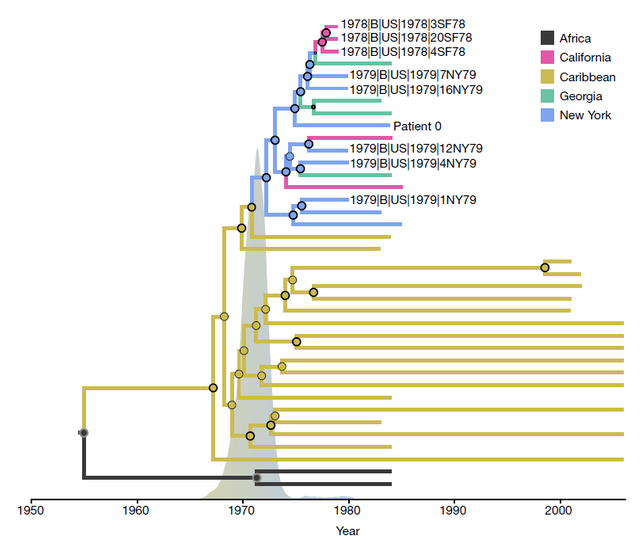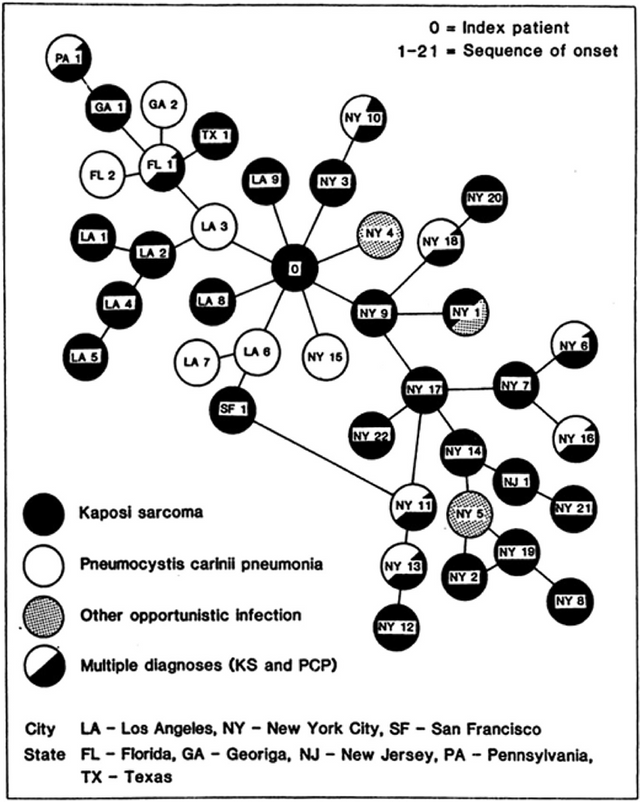Index patient with HIV, probably arrived in New York from Haiti in 1971
Index patient - so-called human medicine, with which the epidemic began. This is the first individual is infected.
For example, take the global epidemic of HIV, which covered almost all of the country and claimed the lives of more than 25 million people. Every day from this disease die 14 people, and about 42 million are living with the virus. Although infectious disease is now well understood, but the rate of its spread is still high, the number of infected and the number of deaths is growing.
For a long time it was believed that the global HIV epidemic began with one man gay named Gaëtan Dugas, in the photo. He was called by the patient zero. Now an international team of researchers conducted a genetic study of early HIV samples and found some details of how it was in reality.

Gaetan Dugas (1953-1984) gained universal recognition as the zero of the patient after the release in 1987 of the book "And the orchestra continued to play" journalist Randy Shilts. The author vividly called the hero of "zero patient" for his promiscuous, which is why the infection got thousands of people - and in the US it could not be stopped. Gaetan worked for Air Canada flight attendant airlines and their profession, and looks just perfect for the rapid spread of infection throughout the country.
The view that Gaetan Dugas is the zero patient has become widespread in society. But from a scientific point of view it is not. Before he had even infected the people, by which received Gaetan virus.
The results of the genetic study published a group of scientists led by evolutionary biologist Michael Worobey. She found that Dugas could be zero patients in the United States. The initial infection occurred in another time and another place.
Until recently, scientists had only one patient specimen of the genome of HIV-1, dated to 1980, and this patient was from Africa. At the same time doctors are inclined to believe that the global HIV epidemic began in the United States. But the study of the topic was complicated by the absence of the genomes of infected patients. To fill this gap, Michael Sparrow and colleagues conducted a screening and sequencing of samples of serum taken from homosexual patients from New York and San Francisco in the 1978-1979 biennium. At that time nobody knew about HIV, but Gay took samples for hepatitis B, and serum was preserved until now.
Among the 2231 samples positive for HIV-1 were 83. Twenty of these were subjected to genomic sequencing. Researchers have improved techniques to dramatically increase the probability of detection of HIV-1 in the samples and to extract them from the complete genomic sequences of HIV-1. Five samples from New York and three in San Francisco provided enough data for genome assembly, that is, combining a large number of short DNA in a long sequence. Bayesian phylogenetic analysis of the genome of HIV-1 was carried out. The result is shown in the diagram.

The analysis showed that although these patterns are the oldest examples outside Africa, they do not come into contact with the main branch, even for subtype B (this subtype predominates in Europe and the US, while the subtype A predominates in some parts of Africa). Instead, the US HIV genomes of 1970 and the entire US epidemic overall phylogenetic branches off from the more genetically diverse and old subtype B epidemic in the Caribbean countries - Haiti, Dominican Republic, Trinidad and Tobago, Jamaica. HIV-1 samples collected from immigrants of the Caribbean are marked on the diagram golden color.
Based on the phylogenetic analysis of available data, the scientists concluded that the HIV-1 samples of the Caribbean are the ancestors of the American (probability 99%) and are derived from an ancestor in the interval 1963-1970 gg (probability 95%). All this allows confident enough to suggest that the HIV epidemic came to America from the Caribbean, but not vice versa.
Geographical analysis and dating of samples of HIV-1 molecular clock allows quite accurate to assume the date when HIV came from the Caribbean to the United States. Probably, it happened in 1971, long before the blood samples, which experts analyzed were now taken.
The following diagram shows the alleged dating of infection by molecular clocks and hypothetical route of HIV transmission. The researchers suggest that the virus came from Africa to Haiti (the date of transition is unknown). From Haiti, he was in New York, and from there spread to the United States and around the world.
However, the flight attendant Gaetan Dugas to this quite involved, so that his memory can be considered free of the dirty insinuations. He was not index patient.

Cluster sexual contact 40 patients infected with AIDS at the beginning of the spread of infection. Index patient indicated at 0.
Home HIV infections occurred in New York and San Francisco was in 1971, at the height of the sexual revolution, under the slogan of the hippie movement. People who believe in the beauty and freedom, were very loved-up - and many were victims of the deadly virus.
The scientific work is published October 26, 2016 in the journal Nature (doi: 10.1038 / nature19827).